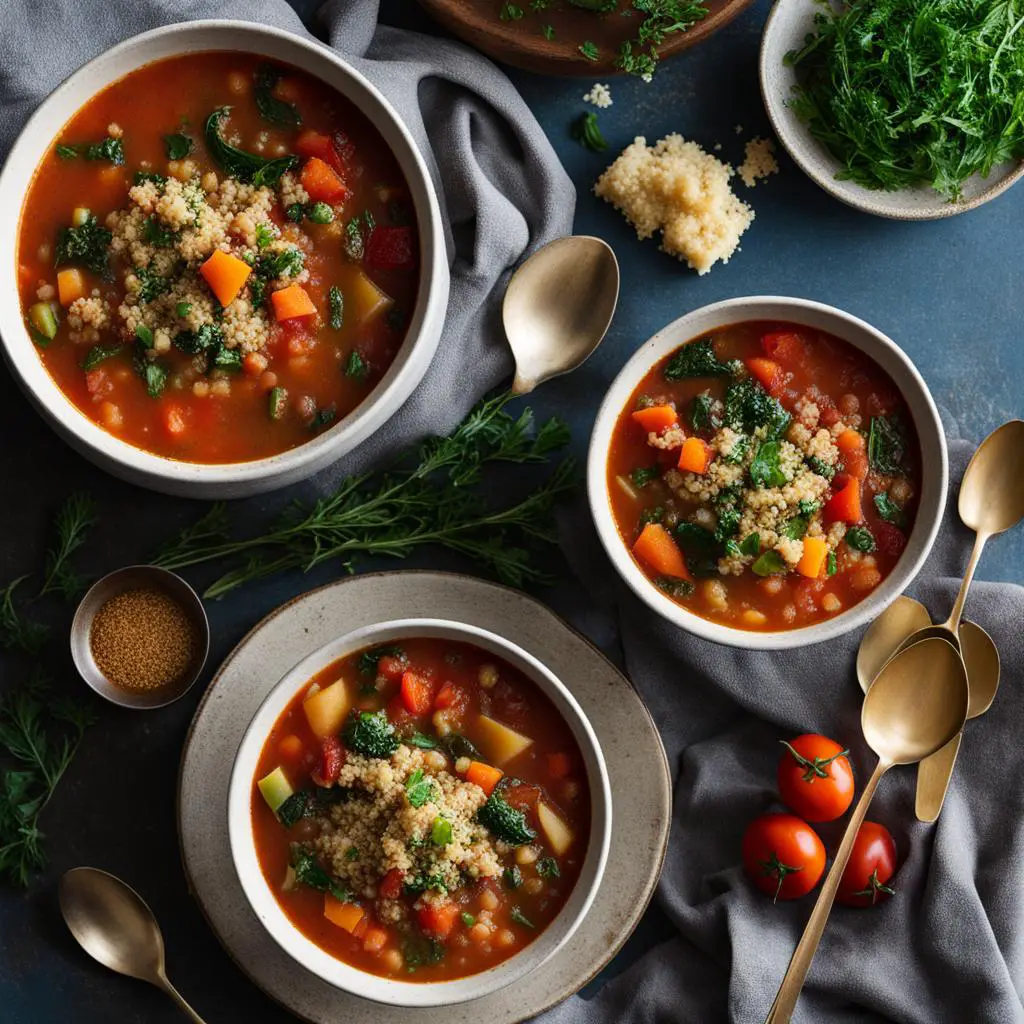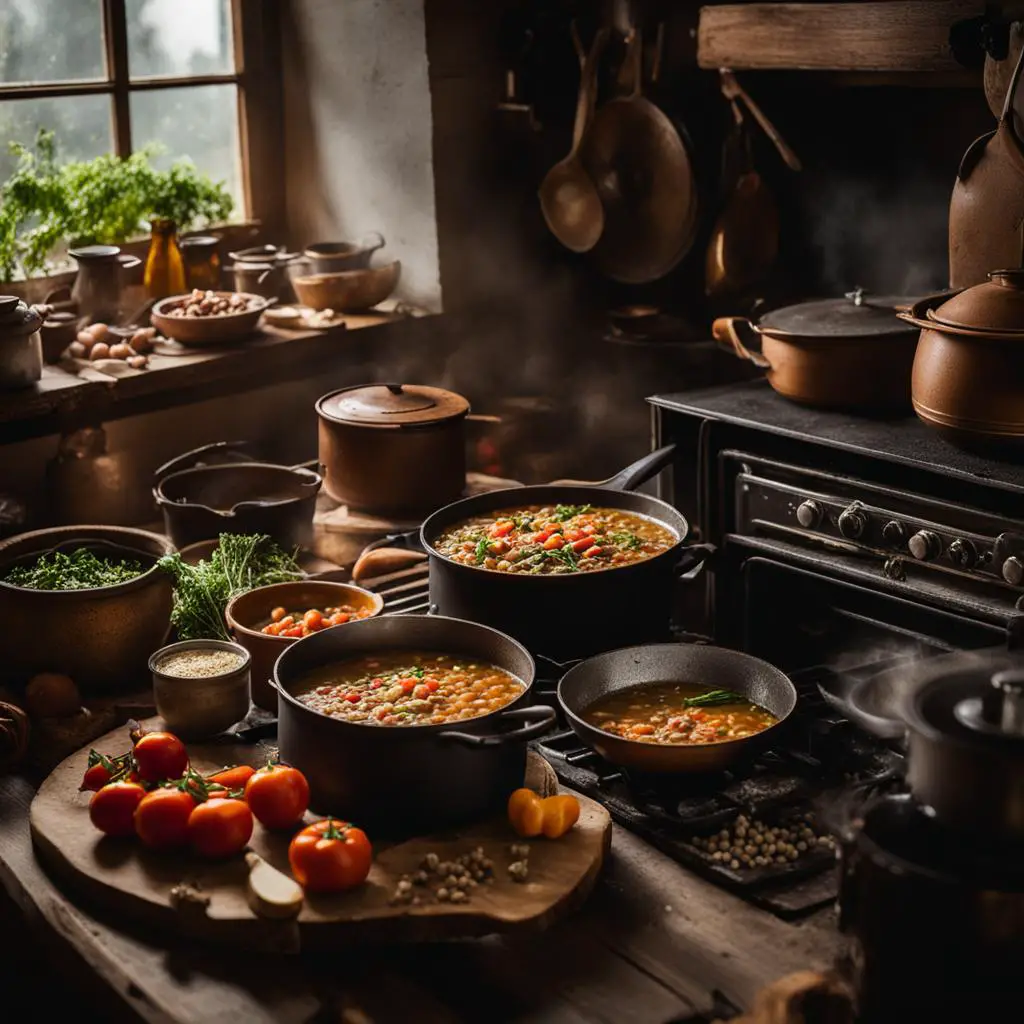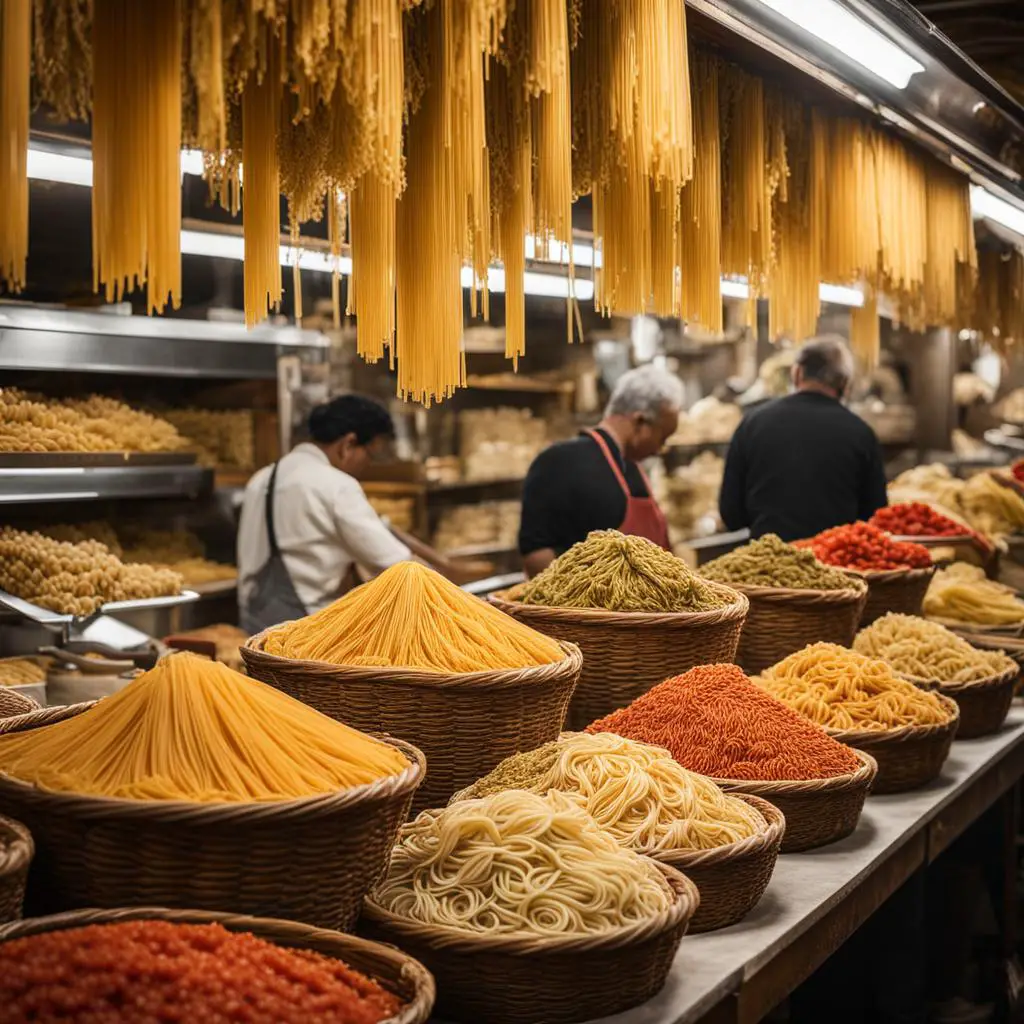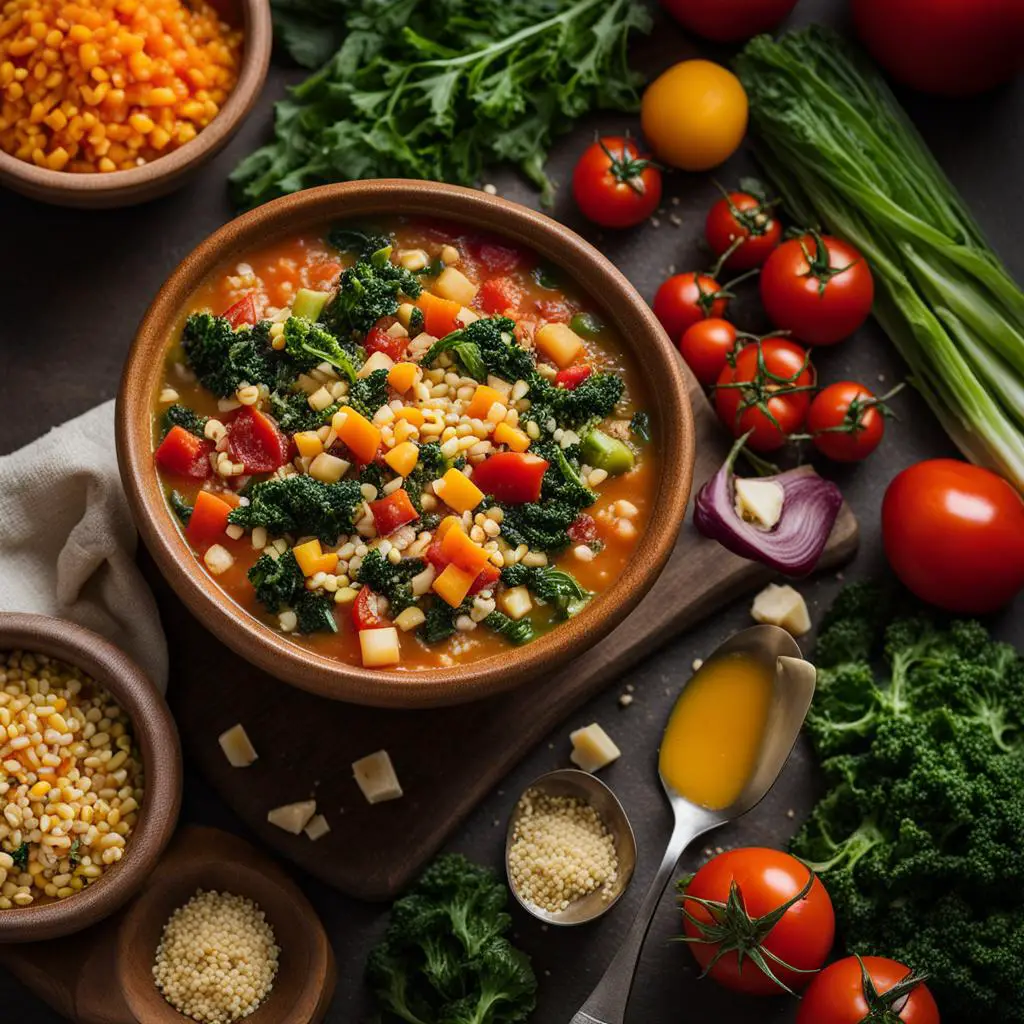Welcome to the world of mouth-watering vegan recipes! Today, we dive into the delectable realm of plant-based soups and creams with a delightful recipe for Minestrone with Quinoa. Get ready to tantalize your taste buds with a soup that not only satisfies your cravings but also nourishes your body from the inside out.
Discover the Magic of Minestrone with Quinoa
If you’re searching for a hearty and wholesome vegan dish, look no further. Our Minestrone with Quinoa recipe combines the classic flavors of traditional Italian minestrone with the power-packed benefits of quinoa. This delightful soup is not only bursting with flavor, but it’s also packed with essential nutrients that will leave you feeling satisfied and nourished.
Key Takeaways:
- Minestrone with Quinoa is a tantalizing vegan recipe that combines the goodness of traditional Italian minestrone with the power-packed benefits of quinoa.
- This soup is not only bursting with flavor but also packed with essential nutrients, making it a perfect choice for plant-based diets.
- By using plant-based ingredients, such as fresh vegetables and vegetable broth, this recipe caters to vegans and those with dietary restrictions.
- Minestrone with Quinoa is a versatile dish that allows for variations and substitutions, making it customizable to personal taste preferences and dietary needs.
- With its rich history in Italian cuisine and the significance of pasta, Minestrone with Quinoa is a delightful addition to any kitchen.
The Health Benefits of Minestrone with Quinoa
Minestrone with Quinoa is a powerhouse of health benefits that will nourish both your body and taste buds. This nutrient-dense soup combines the goodness of quinoa, a complete protein rich in essential amino acids, with a vibrant blend of fresh vegetables. The result is a hearty and delicious dish that supports overall well-being.
Quinoa, the star ingredient of this recipe, is not only a great source of plant-based protein but also loaded with dietary fiber. Its high fiber content promotes healthy digestion and helps you feel full and satisfied. Additionally, quinoa is gluten-free, making this soup suitable for individuals with gluten sensitivities or intolerances.
The colorful medley of vegetables in Minestrone with Quinoa provides a wide array of vitamins, minerals, and antioxidants. From the lycopene-rich tomatoes to the immune-boosting garlic, each ingredient offers unique health benefits. This soup is particularly beneficial for heart health due to its high content of potassium and antioxidants, which can help lower blood pressure and reduce the risk of cardiovascular diseases.
“Minestrone with Quinoa is a powerhouse of health benefits that will nourish both your body and taste buds.”
What sets this recipe apart is the use of vegetable broth instead of traditional chicken broth, making it suitable for vegans and those with dietary restrictions. The absence of animal products not only contributes to a more sustainable and compassionate diet but also reduces the intake of saturated fats and cholesterol.
| Health Benefits of Minestrone with Quinoa | Keywords |
|---|---|
| Complete protein from quinoa | Quinoa, protein, amino acids |
| High in dietary fiber | Fiber, digestion, satiety |
| Loaded with vitamins, minerals, and antioxidants | Vitamins, minerals, antioxidants |
| Promotes heart health | Heart health, potassium, antioxidants |
| Suitable for vegans and dietary restrictions | Vegans, dietary restrictions |
Whether you are looking to incorporate more plant-based meals into your diet or simply want to enjoy a tasty and nourishing soup, Minestrone with Quinoa is the perfect choice. Its health benefits, versatility, and delightful flavors make it a recipe worth trying. So grab your soup pot and start cooking up a bowl of goodness!
How to Make Minestrone with Quinoa

Ready to whip up a delicious and nutritious bowl of Minestrone with Quinoa? Follow these simple steps to create a hearty and satisfying soup that’s perfect for any occasion.
Gather Your Ingredients
Before you begin, make sure you have all the necessary ingredients for your Minestrone with Quinoa. Here’s what you’ll need:
- 1 cup quinoa, rinsed
- 2 tablespoons olive oil
- 1 onion, diced
- 2 cloves garlic, minced
- 2 carrots, diced
- 2 celery stalks, diced
- 1 zucchini, diced
- 1 can diced tomatoes
- 4 cups vegetable broth
- 1 teaspoon dried oregano
- 1 teaspoon dried basil
- Salt and pepper to taste
Once you have all your ingredients ready, it’s time to start cooking!
Step-by-Step Instructions
1. In a large pot, heat the olive oil over medium heat. Add the onion and garlic, and sauté until the onion becomes translucent.
2. Add the carrots, celery, and zucchini to the pot, and cook for another 5 minutes, stirring occasionally.
3. Pour in the diced tomatoes and vegetable broth, along with the oregano and basil. Bring the mixture to a boil, then reduce the heat and let it simmer for 15 minutes.
4. Stir in the rinsed quinoa and continue cooking for another 15 minutes, or until the quinoa is cooked through and tender.
5. Season with salt and pepper to taste.
Serving and Storing
Your Minestrone with Quinoa is now ready to be enjoyed! Ladle the soup into bowls and garnish with fresh herbs, if desired. Serve it alongside crusty bread for a complete meal.
If you have any leftovers, store them in an airtight container in the refrigerator for up to 3 days. You can also freeze the soup for longer storage.
The History of Minestrone Soup

Minestrone soup has a rich and storied history that spans centuries. Its origins can be traced back to ancient times, with evidence of similar vegetable-based soups found in Roman and Greek cultures. However, it was in Italy that minestrone soup truly flourished and became a beloved staple in Italian cuisine.
The exact origin of minestrone is still a matter of debate among historians and culinary experts. Some believe that the soup has its roots in the Roman Empire, where it was made using whatever vegetables were in season, as well as grains and legumes. Others suggest that it was introduced to Italy by the Arabs during the Middle Ages, who brought with them the concept of combining vegetables and grains in soups.
Regardless of its precise origin, minestrone soup has always been a hearty and versatile dish that reflects the agricultural traditions of the Mediterranean region. It was traditionally considered a peasant dish, as it made use of affordable and readily available ingredients. Over time, different regions of Italy developed their own variations of minestrone, incorporating local vegetables and flavors.
“Minestrone soup has a rich and storied history that spans centuries.”
The Evolution of Minestrone Soup
The evolution of minestrone soup mirrors the history of Italy itself. As the country went through various political, cultural, and culinary changes, so did the soup. In the early days, minestrone was a simple peasant dish, often consisting of just vegetables, beans, and grains cooked in water. However, as Italy’s culinary traditions developed and evolved, so too did the ingredients and preparation methods of minestrone.
With the introduction of tomatoes to Italian cuisine in the 16th century, minestrone began to take on a more vibrant and flavorful character. Tomatoes became a common ingredient in minestrone, adding a rich and tangy element to the soup. Other ingredients, such as pasta, cheese, and herbs, were also incorporated over time, further enhancing the taste and texture of the dish.
Today, minestrone soup continues to be a beloved and versatile staple in Italian cuisine. It represents the essence of Italian cooking – simple, flavorful, and made with love. Whether enjoyed on a cold winter’s day or as a light summer meal, minestrone soup remains a comforting and delicious reminder of Italy’s rich culinary heritage.
Pasta: A Delicious Legacy in Italian Cuisine

When it comes to Italian cuisine, one ingredient stands out as a culinary icon – pasta. With its origins dating back centuries, pasta has woven itself into the fabric of Italian culture and cuisine, becoming a beloved staple in households around the world. From classic dishes like spaghetti carbonara to regional specialties like lasagna and ravioli, pasta offers endless possibilities and flavors that satisfy the palate. Let’s explore the historical origins of pasta and its significance in Italian cuisine.
Origins of Pasta
The history of pasta can be traced back to ancient times, with evidence of its consumption found in various cultures around the world. However, it was the Italians who truly embraced pasta and elevated it to a culinary art form. The precise origins of pasta are still a subject of debate, but it is widely believed that pasta was introduced to Italy through trade routes from the Middle East. Arab merchants brought a form of pasta known as “itriyya” to Sicily, which eventually spread throughout the country.
| Year | Significant Event |
|---|---|
| 1154 | The first documented recipe for pasta appears in the book “De arte Coquinaria per vermicelli e macaroni siciliani” by Maestro Martino. |
| 17th century | Pasta making becomes more widespread, with different shapes and varieties emerging. |
| 19th century | Pasta production becomes industrialized, making it more accessible and affordable. |
Over time, pasta became deeply ingrained in Italian culture, evolving into the diverse range of shapes, sizes, and textures we know today. Each region of Italy has its own unique pasta specialties, showcasing the country’s rich culinary heritage.
The Significance of Pasta in Italian Cuisine
Pasta holds a special place in Italian cuisine, not only for its delicious taste but also for its versatility and adaptability. It serves as a blank canvas for a variety of flavors, sauces, and ingredients, allowing for endless culinary creations. Whether it’s a hearty bowl of spaghetti Bolognese or a delicate plate of linguine with seafood, pasta acts as the foundation for countless mouthwatering dishes.
“The beauty of pasta lies in its simplicity. Just a few ingredients can come together to create a dish that warms the heart and satisfies the soul.”
By combining pasta with fresh ingredients such as tomatoes, olive oil, garlic, and herbs, Italians have mastered the art of creating flavorful and comforting dishes that have stood the test of time. Pasta has become a symbol of Italian hospitality and culture, inviting people to come together and share a meal with loved ones.
In conclusion, pasta holds a cherished place in Italian cuisine, representing the rich history and creativity of a culinary tradition that has spanned centuries. From its ancient origins to its modern-day variations, pasta continues to delight diners with its endless possibilities. So, next time you savor a bowl of pasta, remember that you’re not just enjoying a delicious meal, but also a taste of Italian heritage.
Variations and Substitutions for Minestrone with Quinoa

When it comes to Minestrone with Quinoa, the possibilities are endless. This versatile soup can be easily customized to suit your taste preferences and dietary needs. Here are some variations and substitutions to consider:
1. Vegetable Options:
While the traditional Minestrone soup includes vegetables like carrots, celery, and tomatoes, you can experiment with different combinations. Add in some zucchini, bell peppers, or kale for a twist. Don’t be afraid to get creative and use seasonal vegetables for added flavor and freshness.
2. Protein Sources:
Quinoa is already a great source of protein, but you can further enhance the protein content of your Minestrone by adding different beans or legumes. Try kidney beans, cannellini beans, or chickpeas for extra texture and protein. If you prefer a meaty element, you can also include diced tofu or seitan as a substitute.
3. Seasonings and Herbs:
Spice up your Minestrone with Quinoa by playing around with different seasonings and herbs. Try adding basil, oregano, or thyme for a Mediterranean twist. If you enjoy a bit of heat, sprinkle in some chili flakes or paprika. Don’t be afraid to experiment and find a flavor profile that suits your taste buds.
Remember, the key to a successful Minestrone with Quinoa is to have fun and make it your own. Whether you’re swapping out vegetables, trying new protein sources, or adding unique seasonings, the variations and substitutions are endless. So grab a pot, unleash your culinary creativity, and enjoy a bowl of wholesome and delicious Minestrone with Quinoa!
| Variation | Description |
|---|---|
| Minestrone with Roasted Vegetables | A twist on the classic recipe, this variation features roasted vegetables for a deeper flavor profile. Roast carrots, onions, and mushrooms until tender, then add them to your soup for a rich and satisfying meal. |
| Asian-inspired Minestrone | Add an Asian flair to your Minestrone by incorporating ingredients like bok choy, shiitake mushrooms, and tamari sauce. Garnish with fresh cilantro and green onions for an extra burst of flavor. |
| Spicy Mexican Minestrone | If you crave heat, this variation is for you. Incorporate jalapenos, black beans, and corn into your soup, and season with cumin, chili powder, and lime juice. Top with avocado slices and cilantro for a satisfying Southwestern twist. |
“Variety is the spice of life, and the same goes for Minestrone with Quinoa. Don’t be afraid to get creative and try different ingredients and flavors. The beauty of this soup lies in its versatility, so make it your own and enjoy a delicious and nourishing meal.”
Can I Substitute Quinoa for Peas in the Minestrone Soup Recipe?
When making minestrone soup, it is not advisable to substitute quinoa for peas. Quinoa has a distinct texture and taste compared to peas, which could alter the overall flavor profile of the soup. However, if you are looking for a refreshing twist, consider adding peas to your pea mint soup recipe for a burst of freshness and subtle sweetness.
Conclusion
Congratulations! You’ve reached the end of this delightful journey through the world of Minestrone with Quinoa. Let’s summarize the highlights of what you’ve discovered along the way.
The Perfect Choice for Vegans and Plant-Based Diets
Minestrone with Quinoa is a vegan recipe that hits all the right spots when it comes to nutrition. Packed with protein, fiber, and an array of vegetables, this soup is a powerhouse of goodness. It’s the perfect addition to a plant-based diet, fueling your body with essential nutrients and keeping you satisfied.
A Flavorful Blend of Tradition and Innovation
By combining the classic flavors of Italian minestrone with the modern twist of quinoa, this recipe takes you on a culinary adventure. The result is a soup that not only tastes amazing but also provides a wholesome dining experience. You get to savor the time-honored tradition of Italian cuisine while enjoying the health benefits of this innovative twist.
Endless Possibilities for Personalization
Don’t be afraid to get creative with your Minestrone with Quinoa. The beauty of this recipe lies in its adaptability. You can switch up the vegetables, experiment with different beans, and play around with seasonings to suit your taste. The possibilities are endless, allowing you to make this soup truly your own.
In conclusion, Minestrone with Quinoa is a soup that ticks all the boxes. It’s delicious, nutritious, and versatile, making it a must-try for anyone looking to elevate their plant-based cooking game. So grab your apron and get ready to impress your taste buds with this delightful dish!
FAQ
Is Minestrone with Quinoa suitable for vegans and those on a plant-based diet?
Yes, Minestrone with Quinoa is a great option for vegans and those following a plant-based diet. It is made with vegetable broth and packed with nutritious vegetables and quinoa.
What are the health benefits of Minestrone with Quinoa?
Minestrone with Quinoa is a nutrient-dense soup that offers numerous health benefits. It is a good source of protein and dietary fiber, supports heart health, aids digestion, and promotes satiety.
How do I make Minestrone with Quinoa?
Making Minestrone with Quinoa is a simple process. You will need to chop and prepare the vegetables, rinse the quinoa, and cook everything together in a pot. Detailed step-by-step instructions can be found in the article.
What is the history of Minestrone soup?
Minestrone soup has a rich history dating back to ancient times. It originated in the Mediterranean region, particularly in Italy, and has evolved over time, incorporating different ingredients and culinary influences.
Why is pasta significant in Italian cuisine?
Pasta has a long and fascinating history in Italian cuisine. It has been enjoyed in various forms since ancient times and has become a staple food in Italian households. The article explores the historical origins of pasta and its role in Italian cooking.
Can I customize Minestrone with Quinoa?
Yes, Minestrone with Quinoa is a versatile soup that can be customized to individual preferences. The article provides suggestions for variations and substitutions, allowing you to adapt the recipe to your liking.
Welcome to VeganClue - My name is Robert Van De Ville and together with my team we spent hundreds of hours researching the most relevant topics for Vegans and non yet Vegans. Are you looking for more information about Veganism, animal welfare, diet, health, and environmental benefits of the Vegan lifestyle? You are in the right place! Enjoy the site.


